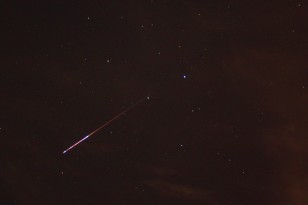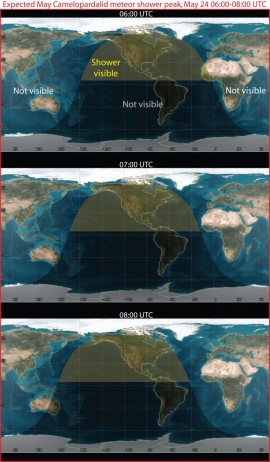
A meteor from the August 2009 Perseid meteor shower streaks across the Texas night sky. (Jared Tennant via Wikimedia Commons)
If you live in North or Central America, you just might have front row seats to a rare and spectacular meteor shower.
Scientists said that the view might even better if you happen to be in the northwestern United States or in southern Canada
NASA said the shower — dubbed the May Camelopardalids, which can mean either ‘camel leopard’ or giraffe in Latin — could possibly light up the sky sometime between 0230 and 1100 UTC on May 24.
This celestial light show should take place early Saturday morning, but scientists aren’t absolutely sure. Since this is a new meteor shower, there’s also a chance that it might take place at another time or possibly not at all.
At its peak, which should be between 0600 and 0800 UTC, May 24, the May Camelopardalids could produce about 200 or so meteors per hour.

Projected viewing of May Camelopardalids meteor shower at its peak 0600 – 0800 UTC May 24, 2014 (NASA)
A meteor shower occurs when a number of meteors originate from one point in the night sky. They are caused by cosmic debris which enters the Earth’s atmosphere at extremely high speeds on parallel trajectories.
The new meteor shower is being produced because Earth will be making its way through a field of dust and other debris generated by Comet 209P/LINEAR, which is looping back into the deep solar system after a recent rendezvous with the Sun.
The comet doesn’t seem to be particularly active at the moment, but it is dragging some of the refuse material it ejected in its previous 5-year trips around the sun. The amount of remaining debris will also factor into how active a meteor shower this will be.
Part of the comet’s name – LINEAR – is actually an acronym for Lincoln Near-Earth Asteroid Research which is the name of a research project that discovered the comet back in February 2004.
The comet got within about 13,463,808 kilometers of the Sun back on May 6, 2014. The 209P/LINEAR is also supposed to get pretty close to Earth on May 29, 2014 where it’ll pass us from a distance of about 5,983,915 kilometers.
Along with the upcoming May Camelopardalids, stargazers will also be getting set to observe two of the most popular annual meteor showers, the Perseid, which peaks in August and the Leonid meteor showers that usually takes place every November.





















The meteor shower was a bust. I only saw two in an hour – between 2-3 am CDT May 24, 2014.
Why would this be a new meteor shower if the comet makes 5-year trips around the Sun?
The earth doesn’t pass through the comet’s tail every time the comet orbits the sun. Even if the two objects’ orbits intersected every time, if the earth were somewhere else on its orbit when the comet passed through the earth’s orbit, there would be no shower. In fact, the two orbits may only intersect rarely, since the comet’s orbit is likely to be slightly changed (“perturbed”) if it passes near other planets in the solar system on its way out to deep space, or back in.
Only when the two orbits intersect, _and_ the earth and the comet are near enough to each other, does the earth pass through the comet’s tail. The tail particles then enter the earth’s atmosphere, creating the meteor shower.
Interesting fact: A comet’s tail doesn’t actually follow the comet all the time, so it’s not really a tail at all. It is a stream of particles that the sun’s energy liberates from the comet’s surface, and pushes away. So, the tail actually points away from the sun, and has no relation to the direction of the comet.
Jaxter, thank you for the answer. Doesn’t the explanation you have given about this comet apply to other comets? Is it consistent with the reality that we do have annual meteor showers? I realize I am asking simple questions that may require complex answers and likely too complex for me to understand. I thank you also for the added “interesting fact.”